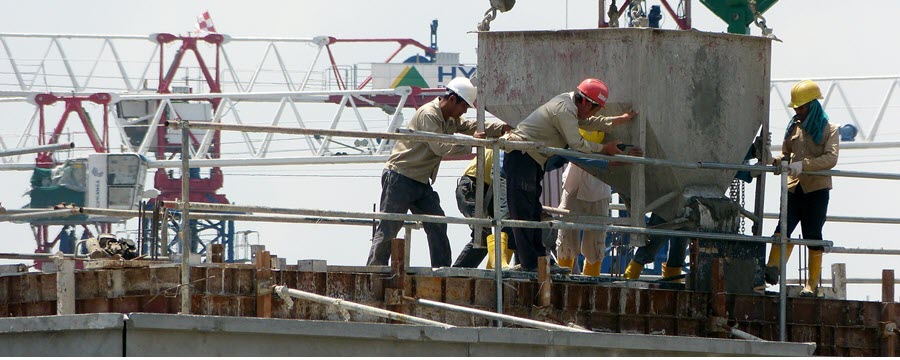
Top Causes of Back Injuries in Construction

Working in construction involves lots of heavy lifting and bending, and occasionally manual labor at great height. These responsibilities can easily cause back strain. In fact, 40% of construction workers over the age of 50 report chronic back pain.
What can industry professionals do to mitigate pain and maintain worksite safety? Learn how back pain can be triggered and take safety steps where possible. The following are some of the main causes of back injuries in construction.
1. Repeated Lifting
Contractors spend their day lifting heavy materials such as concrete slabs. These can weigh about 150 pounds per cubic foot. The excess weight puts pressure on the builder’s back, potentially causing a herniated disc.
When lifting, workers should stand with a wide stance and hold the object close to their body. In addition, lift with the legs and not the back and don’t twist too much. If the object is too heavy it’s a good idea to ask for help.
On a management level, there are a few tactics to use to reduce the impact of repeated lifting that can lead to back injuries in construction. Employers who can should invest in more transportation equipment for heavier objects. Plus, alternate assigning heavy and light tasks and give workers extended breaks. Proper rest between labor-intensive activities can reduce fatigue and injury while still keeping a project moving.
2. Consistent Lifting and Twisting Motion
All the lifting and twisting can tighten the back. When placing new roofing panels, for example, the worker has to lift the tile and then turn to place it in the right spot. But that twisting motion can overstretch or tear large muscles or ligaments. Sometimes these then become inflamed.
Good form is essential for long-term health. When lifting objects and completing manual labor, it’s important to keep the back as straight as possible. Also, ensure the shoulders, hips, and toes are facing the same direction and bend with the knees.
To help prevent back injuries in construction — or anywhere lifting is required — employers can make small changes. These can include things such as changing the layout of a jobsite. Have materials delivered close to where they will be used and store them off the ground to limit twisting, lifting, and bending.
3. Bending for Long Periods
Construction tasks require bending for many hours. For example, it can take one to two days to install a new roof. The prolonged bending can irritate the back. Why? Curling into a “C” shape puts pressure on the spine.
Good form is again important for mitigating stress. So, instead of bending with the back, using the hips can relieve back tension. In addition, workers should stand as close to the load as possible and tighten their muscles.
Back injuries in construction can also result from falls, which are more likely to happen when working at height. That’s why it’s essential to inspect the roof for any signs of structural damage first. When on the scaffolding, builders should wear the proper safety gear, such as hard hats. It’s also important to know the load capacity of the structure.
4. Pulling and Tugging of Materials
During the demolition of homes, materials are consistently pulled out. Also, many renovations require tugging out materials, like old drywall. However, this can cause lumbar strain, which leads to sudden lower back pain and spasms.
Therefore, builders need to use both hands and limit the amount of weight they pull at once. In addition, employers should have safety meetings to discuss proper handling.
5. Quick Body Movements
Since a lot is going on at a construction site, workers need to react quickly. For example, an unsteady piece of siding can cause damage if it’s not caught. The sudden movement can strain their muscles or ligaments.
To keep employees from carrying out unsafe motions, managers need to implement safety practices. For example, ensure the work area isn’t cluttered with building supplies or tools. Before operating machinery, check its condition and conduct on-site training. Plus, builders should have a radio or cell phone with them at all times.
6. Tool and Equipment Vibrations
When operating heavy machinery, workers’ bodies experience vibrations. This motion can cause the back muscles to become sore, which can lead to back injuries in construction. They might also cause muscle damage to other parts, like the arms and hands.
What can construction teams do about equipment vibrations? Use machinery on lower power settings and implement task rotations. Also, thoroughly inspect the equipment before using it to ensure normal operation.
7. Building Cement Structures
Cement is a common material used in building foundations and structural elements. Fabricating cement structures involves lifting heavy materials and bending down frequently. For example, workers may need to manipulate concrete placement hoses. The repeated process can cause back strain.
Workers must take care to rest regularly and practice proper lifting techniques. Also, technology can help prevent injuries. For example, exo-suits are wearable exoskeletons hitting the market right now that can assist with safe, heavy lifting.
Common Causes of Back Injuries at Construction Jobsites
Contractors work on building projects in which they are constantly in motion. With that comes muscle strain and other pressures on the body. To stay safe and productive, it’s important to know these common causes of back pain in construction and take measures to eliminate them whenever necessary.
Safe Lifting Resources:
- OSHA construction safety site
- OSHA advice on heavy lifting
- Safer pushing, pulling and carrying
- NIOSH: An effective strategy for reducing back injuries
- Safe lifting signs and labels at ComplianceSigns.com
- General construction safety signs to help keep workers safe

